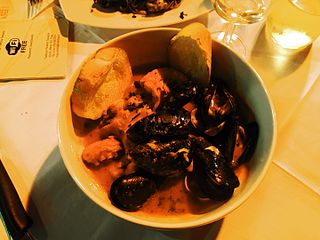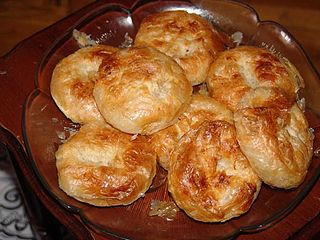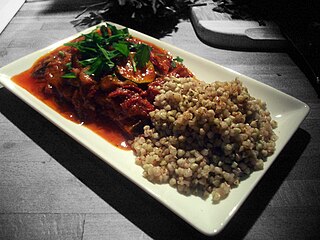
Lancashire hotpot is a stew originating in Lancashire in the North West of England. It consists of lamb or mutton and onion, topped with sliced potatoes and slowly baked in a pot at a low heat.

Jambalaya is a savory rice dish of mixed origins that developed in the U.S. state of Louisiana apparently with African, Spanish, and French influences, consisting mainly of meat or seafood, and vegetables mixed with rice and spices. West Africans and Spanish people each had versions of jambalaya in their respective countries. Historian Ibraham Seck states Senegalese people were making jambalaya. The French introduced tomato to West Africans and they incorporated the crop into their one-pot rice dishes that created jambalaya and enhanced jollof rice. Spanish people made paella which is also a one-pot rice dish cooked with meats and vegetables. These styles of cuisines blended in Louisiana and resulted in cultural and regional variations of the dish.

Maghreb cuisine is the cooking of the Maghreb region, the northwesternmost part of Africa along the Mediterranean Sea, consisting of the countries of Algeria, Libya, Mauritania, Morocco, and Tunisia. Well-known dishes from the region include couscous, pastilla, tajine and shakshouka.

A casserole is a kind of large, deep pan or bowl used for cooking a variety of dishes in the oven; it is also a category of foods cooked in such a vessel. To distinguish the two uses, the pan can be called a "casserole dish" or "casserole pan", whereas the food is simply "a casserole". The same pan is often used both for cooking and for serving.

Peasant foods are dishes eaten by peasants, made from accessible and inexpensive ingredients.

Mediterranean cuisine is the food and methods of preparation used by the people of the Mediterranean Basin. The idea of a Mediterranean cuisine originates with the cookery writer Elizabeth David's book, A Book of Mediterranean Food (1950) and was amplified by other writers working in English.

Cholent or Schalet is a traditional slow-simmering Sabbath stew in Jewish cuisine that was developed by Ashkenazi Jews first in France and later Germany, and is first mentioned in the 12th century. It is related to and is thought to have been derived from hamin, a similar Sabbath stew that emerged in Spain among Sephardic Jews and made its way to France by way of Provence.

Arab cuisine is the cuisine of the Arab world, defined as the various regional cuisines of the Arab people, spanning from the Maghreb to the Mashriq. These cuisines are centuries old and reflect the culture of trading in ingredients, spices, herbs, and commodities. The regions have many similarities, but also unique traditions. They have also been influenced by climate, cultivation, and mutual commerce.

Lebanese cuisine is the culinary traditions and practices originating from Lebanon. It includes an abundance of whole grains, fruits, vegetables, fresh fish and seafood. Poultry is eaten more often than red meat, and when red meat is eaten, it is usually lamb and goat meat. Dishes include copious amounts of garlic and olive oil, and dishes are often seasoned with lemon juice. Chickpeas and parsley are also staples of the Lebanese diet.

Cacciucco is an Italian fish stew native to the western coastal towns of Tuscany. It is especially associated with the port city of Livorno, in Tuscany, and the town of Viareggio north of it.

Bamia is an Arab and Central Asian main dish made with okra, lamb, and tomatoes as primary ingredients. It is commonly made in the following countries and cultures: Afghani, Albanian, Armenian, Assyrian, Azerbaijani, Egyptian, Greek, Iranian, Iraqi, Kurdish, Lebanese, Palestinian, Romanian, Somali, Sudanese, Syrian, Tanzania, and Turkish. Additional ingredients used can include tomato sauce or tomato paste, onion, garlic, cilantro (coriander), pomegranate molasses, vegetable oil, cardamom, salt and pepper.

Shakshouka is a Maghrebi dish of eggs poached in a sauce of tomatoes, olive oil, peppers, onion, and garlic, commonly spiced with cumin, paprika and cayenne pepper. Shakshouka is a popular dish throughout North Africa and the Middle East.

Sephardic Jewish cuisine, belonging to the Sephardic Jews—descendants of the Jewish population of the Iberian Peninsula until their expulsion in 1492—encompassing traditional dishes developed as they resettled in the Ottoman Empire, North Africa, and the Mediterranean, including Jewish communities in Turkey, Greece, Bulgaria, North Macedonia, and Syria, as well as the Sephardic community in the Land of Israel. It may also refer to the culinary traditions of the Western Sephardim, who settled in Holland, England, and from these places elsewhere. The cuisine of Jerusalem, in particular, is considered predominantly Sephardic.

Stuffed peppers is a dish common in many cuisines. It consists of hollowed or halved bell peppers filled with any of a variety of fillings, often including meat, vegetables, cheese, rice, or sauce. The dish is usually assembled by filling the cavities of the peppers and then cooking.

Ratatouille is a French Provençal dish of stewed vegetables that originated in Nice and is sometimes referred to as ratatouille niçoise. Recipes and cooking times differ widely, but common ingredients include tomato, garlic, onion, courgette (zucchini), aubergine, capsicum, and some combination of leafy green herbs common to the region, such as chives or fennel.

A stew is a combination of solid food ingredients that have been cooked in liquid and served in the resultant gravy. Ingredients can include any combination of vegetables and may include meat, especially tougher meats suitable for slow-cooking, such as beef, pork, venison, rabbit, lamb, poultry, sausages, and seafood. While water can be used as the stew-cooking liquid, stock is also common. A small amount of red wine or other alcohol is sometimes added for flavour. Seasonings and flavourings may also be added. Stews are typically cooked at a relatively low temperature, allowing flavours to mingle.

















